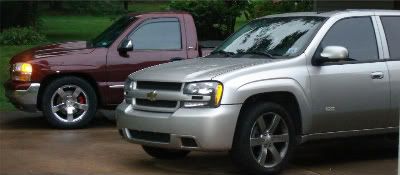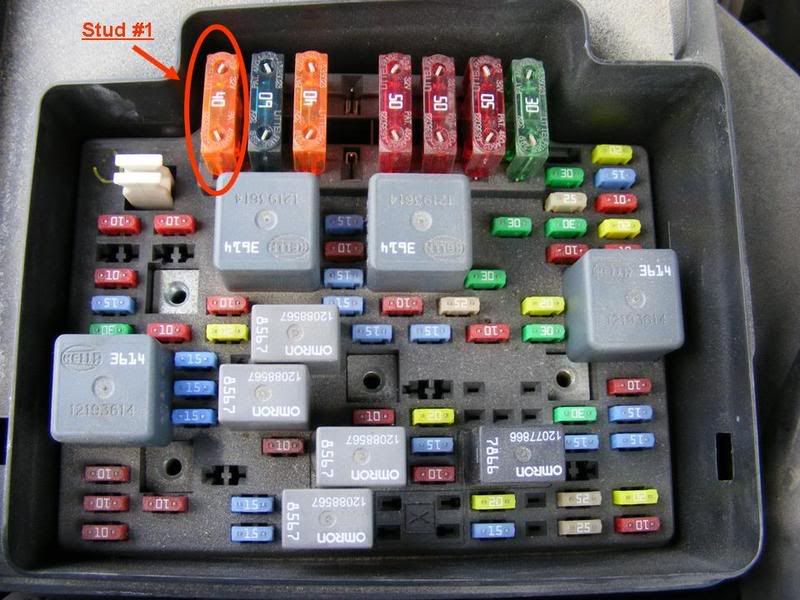While relays are nothing new, very few people understand them and how they work. With a little luck, this page will explain the relay and show some examples of what can be done with them. The unfortunate thing is that so many of the people that use relays don't understand how they work. I've met more than my fair share of (stereo) installers that only know what to do because of instruction books and pre-made wiring harnesses. I was once one of these people, but the amazing simplicity and potential of the standard 12 volt relay was something far too good to go unknown and unused. If it sounds like I'm overdoing it a bit, I'm really not. If you think about how often you use and need relays, you'll soon agree.
The standard 12 volt relay is single pole, double throw. There are five terminals; two to "activate" the relay and the other three are the "switching" terminals. As you can see in the picture above, there are three terminals that are facing up and down, and two that face side to side. For reference, we will consider the uppermost terminal (#30 facing up and down) to be the "top" terminal. Now that we have our orientation, it's time to understand which terminal does what. The two side terminals (#85 and #86) are the "activation" terminals and have no polarity. They simply require +12 volts on one and ground on the other to activate the relay. The terminal on the top will be the common "switching" terminal. This means that it will be the one which is always connected to one of the other two switching terminals. When the relay is not "active," the top terminal is internally connected to the middle terminal (#87a). As soon as the relay becomes activated, the top terminal will break it's internal connection to the middle terminal and become connected to the bottom terminal (#87). Essentially it's just like flipping a normal switch, only its flipping action is controlled from a remote source.
Now that you see how a relay works, what can be done with it and why not just use a switch. There are so many advantages to using relays, I will only be able to mention a few, but I'm sure it will be more than enough to make other ideas and applications come to mind.
One of the most important uses of relays is to control a high power source from a lower power source. As an example, consider that you want to be able to turn on and off something like a set of driving lights that will pull about 30 amps. Obviously, you would need a powerful switch to safely take care of that. I'm sure many can relate to the supplied rocker switch that came with a set of lights, burning out and melting after only a few weeks. Using a relay will allow the use of a small, good looking switch mounted in the dash to activate a relay mounted under the hood to supply power to those lights. Most standard relays (the good ones) can safely handle loads of 30 amps each. There is also the option of tapping off of another switch, such as the headlight power wire, without pulling enough current to affect its circuit. Keeping the main power wires located under the hood and near both the power supply (battery) and the end user (the lights) is also helpful and convenient.
A huge benefit, in cases like this where high current is being used, is the life span of the switch or relay. Even though it may not seem like it, when you flip a rocker switch, it actually takes a long time for it to make contact inside. A long time in electrical terms is still very short, but either way, a switch takes much longer to make its contact than a relay. This long switching time causes internal damage to the switch as an arc is passed across the terminals as they come in contact. The longer it takes to make contact, the longer that arc will burn up the switch. Because a relay is activated much faster, the arc doesn't have the time to cause damage. Sure some will occur, but at such a small amount that a relay will still have a very long life span.
Another use for relays is the ability to control multiple switches at the same time. Say you have a competition stereo system and you want to be able to disconnect all but two speakers from a two channel amp that is running eight speakers. (long story) Obviously, you can't just connect all these speaker leads to a simple switch. There are four wires that would need to be disconnected, two positive (left and right) and two negatives, and none of them can touch each other. Now the advantage of the relay is clear. A small switch can be installed in the dash to activate four relays in the back of the car, disconnecting all the speakers at the same time and without any hassle.
For another use, consider that you want to be able to supply one device from one of two sources. Perhaps you have a temperature gauge and you want to be able to monitor the difference between the coolant temperature in the motor -vs- the temperature in the radiator. Obviously you could use two gauges or a switch, but neither of these would be the best of ideas. Using a relay, you could easily have a small (good looking) switch control a relay that had the gauge going to the top terminal (#30) and each temperature sender going to each of the other switching terminals (#87a and #87). This is a great example of the flexibility of the relay.
While most of the advantages of the relay (I hope) are easy to see, sometimes it's not so obvious. Using switches can have unseen problems. As a switch deteriorates, the internal connections start to build up resistance. This resistance can offer intermittent connections and voltage drops, both of which can be disastrous. The perfect example is when controlling nitrous solenoids. This is the last place you want problems with your wiring! One other thing to add to this is the quality of the relay. As with anything else, quality is everything. For this reason, I highly recommend using only top quality relays such as those offered by either Potter & Brumfield or Bosch (in that order). All too often, products are supplied with low grade relays that wear out quick and cause problems. Any time you buy a product (such as air horns), replace the supplied relay with a better one. While some people will try to screw you on the price, a good relay should never cost more than five dollars. At this price (or hopefully lower) it's just good insurance against problems.
For some good examples of what can be done with relays, check out the pictures below. I will add more over time. If you need help with any other uses, please feel free to let me know.
How to wire a Line Lock
How to wire a Nitrous Kit
How to wire a Trans Brake
How to wire a Nitrous Kit with a Trans Break
(This will prevent the Nitrous from flowing while the Trans Brake is on.)
How to wire Power Windows












 Reply With Quote
Reply With Quote








